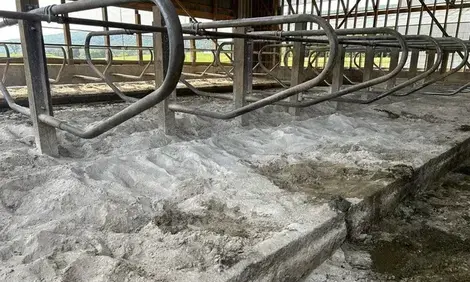



Putting Figures to The Inefficiency of Muddy Feedlots
Mud lowers cattle efficiency and a Kansas State University researcher has attached figures to the impact mud can have in feedlots.Chris Reinhardt, extension feedlot specialist for Kansas State University, understands that part of raising cattle is dealing with the weather and encourages livestock producers to take precautions that reduce stress from muddy pen conditions.
“Rain, snow, ice and extreme temperatures are a part of life in Kansas,” Reinhardt said. “However, each of these factors can steal a measure of the animal’s performance as that animal moves outside of its comfort zone, called the thermal neutral zone.”
Thermal neutral zone for healthy cattle is 23 degrees to 77 degrees Fahrenheit. When the temperature outside falls below or rises above the animal’s comfort zone, the body needs to produce more energy to stay cool or keep warm.
Feedlots and winter-feeding sites can quickly become muddy after receiving moisture and animals are active. If cattle are too tightly confined and feeding grounds are not sufficiently spread out even calving pastures can become riskily muddy.
Reason for Concern
Reinhardt explained that producers should be concerned with the effects of mud in their pens because of four main reasons.
- Slogging through a muddy pen increases the amount of energy cattle expend, thus reducing the amount of energy left for gain.
- Mud on the hide reduces the insulation effects of the hair coat, increasing cold stress, reducing energy left for gain.
- Muddy lots in a feed yard make lying down to rest uncomfortable, resulting in more time spent standing, increasing energy expenditure, reducing energy left for gain.
- Muddy hides reduce dressing percentage at the packing plant, causing an increase in processing costs.
“Under stress-free conditions, only about half of animals’ normal daily energy intake goes toward gain,” Reinhardt said. “All these increases in energy expenditures dramatically cut into what is left over for gain.”
The National Research Council reported that mud four to eight inches deep can reduce feed intake of animals by five to 15 percent.
When the temperature drops between 21 and 39 degrees Fahrenheit, mud that is dewclaw deep has the potential for a seven percent loss of gain and the percentage doubles when the mud reaches shin deep.
Prepare for Mud
Reinhardt encourages producers to prepare for muddy conditions; even though they won’t eliminate the costs proper planning can reduce them. He suggests the following:
• Build and repair mounds within the pen. Cattle should have about 25 square ft. of mound space per animal in the pen. Mounds should have a slope of about 1:5 on the sides to facilitate moisture to flow away from the cattle and the ‘valleys’ between mounds should slope about 3-4 percent away from the bunk. The end of the mound nearest the bunk should connect to the concrete pad so cattle don’t have to slog through deep mud to get to the bunk.
• Increase pen space per animal. Whereas 125 square ft. of pen space is sufficient during dry summer conditions, 350 square ft. may be not nearly sufficient during wet conditions. Adapt as conditions dictate.
• Smooth pen surfaces whenever the weather allows. The longer muddy conditions persist, the worse the pen conditions become and cattle will have an even greater difficulty moving throughout the pen.


